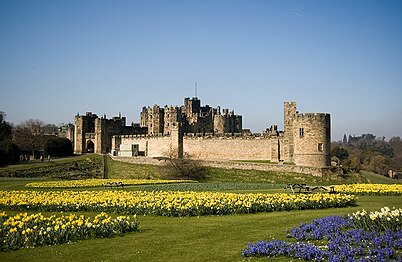Percy family
| Percy | |
|---|---|
House of Brabant (since the late 12th century)House of Smithson (since the mid 18th century) | |
| Country | Kingdom of England, United Kingdom |
| Founded | 1067 |
| Founder | William de Percy (d.1096), 1st feudal baron of Topcliffe |
| Current head | Ralph Percy, 12th Duke of Northumberland |
| Seat | Alnwick Castle |
| Titles | |
| Estate(s) | |
The Percy family is an English noble family. They were among the most powerful noble families in Northern England for much of the Middle Ages. The noble family is known for its long rivalry with the House of Neville, another family powerful in northern England during the 15th century. The Percy-Neville feud led into the Wars of the Roses
The House of Percy descends from William de Percy (d. 1096), a Norman who crossed over to England after William the Conqueror in early December 1067.[dubious ] William de Percy was created 1st feudal baron of Topcliffe in Yorkshire.[4] He was rebuilding York Castle in 1070.
The Percy surname derives[dubious ] from the manor of Percy-en-Auge in Normandy, the home of the Percy family at the time of the Norman Conquest.[5] Family members have held the titles of Earl of Northumberland or Duke of Northumberland to this day, in addition to Baron Percy and others.
The Percy surname twice died out in the male line only to be re-adopted later by the husband or son of a Percy heiress. In the 12th century, the original Percy line was represented by Agnes de Percy, whose son by her husband Joscelin of Louvain adopted the surname. Again in the 18th century, the heiress Elizabeth Seymour married Sir Hugh Smithson, who adopted the surname Percy and was created Duke of Northumberland.[6]
Earls of Northumberland
1309: 1st Baron Percy
In 1309,
1316: 2nd Baron Percy
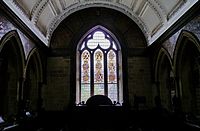
In 1377, the next
The
The
Thereafter, a succession of plots and counterplots—the Rising of the North, the plots to liberate Mary Queen of Scots, and the Gunpowder Plot – each claimed a Percy among their adherents. On this account the
The current duke lives at Alnwick Castle and Syon House, just outside London.
Dukes of Northumberland

The title was created for the third time in 1766 for Hugh Percy, 2nd Earl of Northumberland (formerly Sir Hugh Smithson, 4th Baronet), who had assumed by Act of Parliament in 1750 for himself and his descendants the surname Percy, due to his having married in 1740 the daughter of Algernon Seymour, 7th Duke of Somerset (1684–1750), whose mother
The above steps formed a deliberate move to allow ancient names and titles of the Percys to be revived in the male-heir exhausted senior branch of the Dukedom of Somerset, which at that time was about to see its largest removal – to another noble but very cadet branch (a fourth cousin) on Algernon's death. Algernon was also created Earl of Egremont at the same time, with a different remainder.[12]
In 1784 the 1st Duke was also granted the substantive title Lord Lovaine, Baron of Alnwick in the County of Northumberland, in the Peerage of Great Britain, with remainder to his second son Lord Algernon Percy,[13] who succeeded and who was created Earl of Beverley in 1790, and thus it too became a courtesy title.[14]
The 1st Duke was succeeded in the dukedom and associated titles by his eldest son,
The 5th Duke was succeeded by his eldest son,
Other members of the Percy family
Several other members of the Percy family have also gained distinction.
Family residences
The seat of the Dukes of Northumberland is
Recurring names
Recurring names in the Percy genealogy include:
- Henry (first borne by the 7th feudal baron of Topcliffe and his 10 immediate successors, including the Harry Hotspur)
- Hugh (first borne by the 1st Duke)
- Joscelin/Josceline (first borne by Joscelin of Louvain)
- Algernon (first borne by the 1st Baronas a nickname: Aux Gernons or "with moustaches").
Prominent members
Prominent members of the family include:
- Conquest
- Alan de Percy, 2nd feudal baron of Topcliffe (d. circa 1130–5)[4]
- William II de Percy, 3rd feudal baron of Topcliffe (d. 1174–5), who left two daughters Maud and Agnes as co-heiresses.[24]
- Agnes de Percy (1134-1205), married Dukes of Brabant family tree). He was also brother-in-law to King Henry I, whose second wife was Joscelin's step-sister Adeliza of Louvain.
- Richard de Percy (d. 1244),[24] 5th feudal baron of Topcliffe, signatory to Magna Carta. Died childless. Succeeded his elder brother Henry de Percy (d.1198), the 4th Baron Topcliffe, whose son William III de Percy (1197-1245) became Richard's heir.[24]
- William de Percy, (1197–1245), 6th feudal baron of Topcliffe
- Henry de Percy, 7th feudal baron of Topcliffe (1228–1272)
- Henry de Percy, 1st Baron Percy of Alnwick(1273–1314), 7th feudal baron of Topcliffe and 1st baron by writ.
- Henry de Percy, 2nd Baron Percy of Alnwick(1299–1352)
- Henry de Percy, 3rd Baron Percy of Alnwick (see below)
- Thomas Percy (d. 1369), Bishop of Norwich
- Henry de Percy, 3rd Baron Percy of Alnwick(1320–1368)
- Henry Percy, 1st Earl of Northumberland (1341–1408) (forfeit 1405), helped Henry IV seize the throne, later rebelled against him
- Henry Percy (1364/1366–1403), also called Harry Hotspur, helped Henry IV seize the throne but later rebelled against him, killed at the Battle of Shrewsbury
- Henry Percy, 2nd Earl of Northumberland (see below)
- Lady Elizabeth Percy(c. 1390 – 1437)
- Henry Percy, 2nd Earl of Northumberland (1394–1455), supporter of King Henry VI, killed at the beginning of the Wars of the Roses
- Henry Percy, 3rd Earl of Northumberland (see below)
- Thomas Percy, 1st Baron Egremont (1422–1460)
- Katherine Percy, Countess of Kent(1423 – c. 1475)
- Ralph Percy (d.1464), knight, Lancastrian supporter in the Wars of the Roses
- William Percy (1428–1462), Bishop of Carlisle
- Henry Percy, 3rd Earl of Northumberland (1421–1461) (forfeit 1461), Lancastrian leader in the Wars of the Roses, killed at the Battle of Towton
- Henry Percy, 4th Earl of Northumberland (see below)
- Margaret Percy(b. c. 1447)
- Henry Percy, 4th Earl of Northumberland (1449–1489) (restored 1470), aligned with Yorkists, present but inactive at the Battle of Bosworth Field
- Henry Algernon Percy, 5th Earl of Northumberland (see below)
- Eleanor Percy, Duchess of Buckingham (1474–1530), daughter of the 4th Earl
- Alan Percy (c. 1480 – 1560), son of the 4th Earl, English churchman and academic
- Anne FitzAlan, Countess of Arundel(1485–1552), daughter of the 4th Earl
- Thomas Percy (1560–1605), great-grandson of the 4th Earl, participated in the Gunpowder Plot
- Henry Algernon Percy, 5th Earl of Northumberland(1478–1527)
- Henry Percy, 6th Earl of Northumberland (1502–1537), betrothed to Anne Boleyn
- Thomas Percy (c. 1504 – 1537), participated the Pilgrimage of Grace revolt
- Blessed Thomas Percy, 7th Earl of Northumberland (1528–1572) (forfeit 1571; restored 1572), led the Rising of the North
- Henry Percy, 8th Earl of Northumberland (see below)
- Henry Percy, 8th Earl of Northumberland (1532–1585)
- Henry Percy, 9th Earl of Northumberland (see below)
- George Percy (1580–1632), explorer, author, early governor of Virginia
- Henry Percy, 9th Earl of Northumberland (1564–1632), known as "The Wizard Earl" for his intellectual pursuits, imprisoned after the Gunpowder Plot
- Dorothy Sidney, Countess of Leicester (c. 1598 – 1659)
- Lucy Hay, Countess of Carlisle (1599–1660)
- Algernon Percy, 10th Earl of Northumberland (see below)
- Henry Percy, Baron Percy of Alnwick (d.1659), royalist in the English Civil War
- Algernon Percy, 10th Earl of Northumberland (1602–1668), Lord High Admiral of England, later a Parliamentarian in the English Civil War
- Joceline Percy, 11th Earl of Northumberland(1644–1670), no male heirs, becomes the last male of direct Percy lineage to inherit the Earldom.
- Elizabeth Seymour, Duchess of Somerset (1667–1722), only daughter and heiress of the 11th Earl
- Algernon Seymour, 7th Duke of Somerset, 1st Earl of Northumberland (1684–1750), son of Elizabeth Seymour

- Elizabeth Percy (née Seymour), Duchess of Northumberland, 2nd Baroness Percy (1716–1776), daughter and heiress of the 7th Duke of Somerset, married Sir Hugh Smithson (who adopted the name Percy)
- Hugh Percy, 1st Duke of Northumberland (1714–1786), né Smithson
- Hugh Percy, 2nd Duke of Northumberland (1742–1817), British army officer during the American Revolutionary War
- Hugh Percy, 3rd Duke of Northumberland (1785–1847)
- Algernon Percy, 4th Duke of Northumberland (1792–1865)
- Algernon Percy, 1st Earl of Beverley (1750–1830), second son of the 1st Duke
- George Percy, 2nd Earl of Beverley, 5th Duke of Northumberland (see below)
- Algernon Percy (1779–1833), diplomat
- Hugh Percy (1784–1856), bishop
- Josceline Percy (1784–1856), Royal Navy officer
- William Henry Percy (1788–1855), Royal Navy officer
- Hugh Percy, 2nd Duke of Northumberland (1742–1817), British army officer during the American Revolutionary War
- George Percy, 2nd Earl of Beverley, 5th Duke of Northumberland (1778–1867), politician
- Algernon George Percy, 6th Duke of Northumberland (see below)
- Lord Josceline Percy (1811–1881), politician
- Lord Henry Percy (1817–1877), lieutenant-general in the British Army
- Algernon George Percy, 6th Duke of Northumberland(1810–1899), politician
- Henry George Percy, 7th Duke of Northumberland (see below)
- Lord Algernon Percy (1851–1933), politician
- Henry George Percy, 7th Duke of Northumberland(1846–1918), politician
- Henry Percy, Earl Percy (1871–1909), politician
- Alan Ian Percy, 8th Duke of Northumberland (see below)
- Eustace Percy, 1st Baron Percy of Newcastle (1887–1958), politician
- Alan Ian Percy, 8th Duke of Northumberland(1880–1930)
- Henry George Alan Percy, 9th Duke of Northumberland(1912–1940), killed in World War II
- Hugh Algernon Percy, 10th Duke of Northumberland (see below)
- Elizabeth Douglas-Hamilton, Duchess of Hamilton and Brandon(1916–2008)
- Hugh Algernon Percy, 10th Duke of Northumberland(1914–1988)
- Henry Alan Walter Richard Percy, 11th Duke of Northumberland(1953–1995)
- Ralph George Algernon Percy, 12th Duke of Northumberland(b. 1956)
- Lady Katie Percy (b. 1982)
- George Dominic Percy, Earl Percy(b. 1984)
- Lady Melissa Jane Percy (b. 1987)
- Lord Max Percy (b. 1990), husband of Princess Nora zu Oettingen-Spielberg
Family tree
part of this is taken from the article on the Duke of Northumberland
| William de Perci aux Gernons ("with whiskers", later became a common name in the family, "Algernon") arrived in England from Normandy 1067 from Percy-en-Auge in Normandy 1st feudal baron of Topcliffe, North Yorkshire (d. 1096/9) | |||||||||||||||||||||||||||||||||||||||||||||||||||||||||||||||||||||
| Alan de Perci 2nd feudal baron of Topcliffe (d. circa 1130/5) | |||||||||||||||||||||||||||||||||||||||||||||||||||||||||||||||||||||
| William II de Perci (d. 1174/5) 3rd feudal baron of Topcliffe | Godfrey I, Count of Louvain | Ida of Chiny (1078–1117) | |||||||||||||||||||||||||||||||||||||||||||||||||||||||||||||||||||
| Agnes de Perci (1134-1205) | |||||||||||||||||||||||||||||||||||||||||||||||||||||||||||||||||||||
| Henry de Perci | Mountbattens | ||||||||||||||||||||||||||||||||||||||||||||||||||||||||||||||||||||
| William III de Perci (1197-1245) 6th feudal baron of Topcliffe | King Henry II "FitzEmpress" of England | ||||||||||||||||||||||||||||||||||||||||||||||||||||||||||||||||||||
| Henry de Perci (1228–1272) 7th feudal baron of Topcliffe | |||||||||||||||||||||||||||||||||||||||||||||||||||||||||||||||||||||
Henry de Percy 9th feudal baron of Topcliffe 2nd Baron Percy of Alnwick (1299–1352) | |||||||||||||||||||||||||||||||||||||||||||||||||||||||||||||||||||||
Henry de Percy 10th feudal baron of Topcliffe 3rd Baron Percy of Alnwick (1320–1368) | Mary of Lancaster | Thomas Percy bishop of Norwich (d. 1369) | |||||||||||||||||||||||||||||||||||||||||||||||||||||||||||||||||||
| Margaret Neville | Henry Percy 11th feudal baron of Topcliffe 4th Baron Percy of Alnwick 1st Earl of Northumberland, 1377 forfeit 1405 (1341–1408) | Maud Lucy heiress of Egremont | Thomas Percy 1st Earl of Worcester (1343 – 1403)  | ||||||||||||||||||||||||||||||||||||||||||||||||||||||||||||||||||
| Henry Percy (Hotspur) (1364 – 1403) | Thomas Percy | Ralph Percy | Alan Percy | Mary Percy | |||||||||||||||||||||||||||||||||||||||||||||||||||||||||||||||||
Elizabeth (c. 1390 – 1437) | Henry Percy 2nd Earl of Northumberland, 1416 (1394–1455) | ||||||||||||||||||||||||||||||||||||||||||||||||||||||||||||||||||||
Katherine (1423 Aft. 1475 ) | George Percy (1424 - 1474 ) | Ralph Percy ( 1425 - 1464) | Richard Percy | William Percy Bishop of Carlisle (1428 – 1462) | Joan Percy (1430 - 1482) married Lord Edmund d'Aganet, 8th Baron of Blyth | Anne Percy (1436 - 1522) married Thomas Hungerford of Rowden | |||||||||||||||||||||||||||||||||||||||||||||||||||||||||||||||
| Henry Percy 4th Earl of Northumberland (1449–1489) (restored 1470) | Sir Ralph Percy | Peter Percy | Sir Henry Percy | George Percy | John Percy | ||||||||||||||||||||||||||||||||||||||||||||||||||||||||||||||||
Henry Algernon Percy 5th Earl of Northumberland (1478–1527) | Alan Percy (c. 1480 – 1560) | Joscelin Percy | Richard Pearce | ||||||||||||||||||||||||||||||||||||||||||||||||||||||||||||||||||
| Henry Percy 6th Earl of Northumberland (1502–1537) betrothed to Anne Boleyn | Thomas Percy (c. 1504 – 1537) participated the Pilgrimage of Grace revolt | Edward Percy | |||||||||||||||||||||||||||||||||||||||||||||||||||||||||||||||||||
| Thomas Percy 7th Earl of Northumberland (forfeit 1571; restored 1572) led the Rising of the North (1528–1572) | Henry Percy 8th Earl of Northumberland (1532–1585) | Thomas Percy convicted in the Gunpowder Plot (c. 1560 – 1605) | |||||||||||||||||||||||||||||||||||||||||||||||||||||||||||||||||||
| Henry Percy 9th Earl of Northumberland "the Wizard Earl" (1564–1632) | Thomas Percy | William Percy | Sir Charles Percy | Richard Percy | Sir Joscelin Percy | Sir Alan Percy | Sir George Percy explorer, author, gov. of Virginia (1580–1632) | ||||||||||||||||||||||||||||||||||||||||||||||||||||||||||||||
| Algernon Percy 10th Earl of Northumberland (1602–1668) Lord High Admiral of England, later a Parliamentarian in the English Civil War | Henry Percy Baron Percy of Alnwick (d.1659) royalist in the English Civil War | ||||||||||||||||||||||||||||||||||||||||||||||||||||||||||||||||||||
Joceline Percy 11th Earl of Northumberland (1644–1670) no male heirs, becomes the last male of direct Percy lineage to inherit the Earldom | |||||||||||||||||||||||||||||||||||||||||||||||||||||||||||||||||||||
| Henry Percy Lord Percy (1668–1669) only son and heir apparent | Elizabeth Percy suo jure Baroness Percy (1667 – 1722) | Charles Seymour, 6th Duke of Somerset | |||||||||||||||||||||||||||||||||||||||||||||||||||||||||||||||||||
| Algernon Seymour, 7th Duke of Somerset Baron Percy (1684 – 1750) created Earl of Northumberland, with remainder to his son-in-law | |||||||||||||||||||||||||||||||||||||||||||||||||||||||||||||||||||||
| George Seymour Viscount Beauchamp (1725 – 1744) | Elizabeth Percy suo jure 2nd Baroness Percy (1730 - 1776) | Sir Hugh Percy né Smithson 4th Baronet 2nd Earl of Northumberland by special remainder, 1750, and 1st Duke of Northumberland by creation 1766 (1714 – 1786) | |||||||||||||||||||||||||||||||||||||||||||||||||||||||||||||||||||
This summary genealogical tree shows how the current house of Percy is related:
| Family tree of the Earls and Dukes of Northumberland and Earls of Beverley | |||||||||||||||||||||||||||||||||||||||||||||||||||||||||||||||||||||||||||||||||||||||||||||||||||||||||||||||||||||||||||||||||||||||||||||||||||||||||||||||||||||||||||||||||||||||||||||||||||||||||||||||||||||||||||||||||||||||||||||||||||||||||||||||||||||||||||||||||||||||||||||||||||||||||||||||||||||||||||||||||||||||||||||||||||||||||||||||||||||||||||||||||||||||||||||||||||||||||||||||||||||||||||||||||||||||||||||||||||||||||||||||||||||||||||||||||||||||||||||||||||||||||||||||||||||||||||||||||||||||||||||||||||||||||||||||||||||||||||||||||||||||||||||||||||||||||||||||||||||||||||||||||||||||||||||||||||||||||||||||||||||||||||||||||||||||||||||||||||||||||||||||||||||||||||||||||||||||||||||||||||||||||||||||||||||||||||||||||||||||||||||||||||||||||||||||||||||||||||||||||||||||||||||||||||||||||||||||||||||||||||||||||||||||||||||||||||||||||||||||||||||||||||||||||||||||||||||||||||||||||||||||||||||||||||||||||||||||||||||||||||||||||||||||||||||||||||||||||||||||
|---|---|---|---|---|---|---|---|---|---|---|---|---|---|---|---|---|---|---|---|---|---|---|---|---|---|---|---|---|---|---|---|---|---|---|---|---|---|---|---|---|---|---|---|---|---|---|---|---|---|---|---|---|---|---|---|---|---|---|---|---|---|---|---|---|---|---|---|---|---|---|---|---|---|---|---|---|---|---|---|---|---|---|---|---|---|---|---|---|---|---|---|---|---|---|---|---|---|---|---|---|---|---|---|---|---|---|---|---|---|---|---|---|---|---|---|---|---|---|---|---|---|---|---|---|---|---|---|---|---|---|---|---|---|---|---|---|---|---|---|---|---|---|---|---|---|---|---|---|---|---|---|---|---|---|---|---|---|---|---|---|---|---|---|---|---|---|---|---|---|---|---|---|---|---|---|---|---|---|---|---|---|---|---|---|---|---|---|---|---|---|---|---|---|---|---|---|---|---|---|---|---|---|---|---|---|---|---|---|---|---|---|---|---|---|---|---|---|---|---|---|---|---|---|---|---|---|---|---|---|---|---|---|---|---|---|---|---|---|---|---|---|---|---|---|---|---|---|---|---|---|---|---|---|---|---|---|---|---|---|---|---|---|---|---|---|---|---|---|---|---|---|---|---|---|---|---|---|---|---|---|---|---|---|---|---|---|---|---|---|---|---|---|---|---|---|---|---|---|---|---|---|---|---|---|---|---|---|---|---|---|---|---|---|---|---|---|---|---|---|---|---|---|---|---|---|---|---|---|---|---|---|---|---|---|---|---|---|---|---|---|---|---|---|---|---|---|---|---|---|---|---|---|---|---|---|---|---|---|---|---|---|---|---|---|---|---|---|---|---|---|---|---|---|---|---|---|---|---|---|---|---|---|---|---|---|---|---|---|---|---|---|---|---|---|---|---|---|---|---|---|---|---|---|---|---|---|---|---|---|---|---|---|---|---|---|---|---|---|---|---|---|---|---|---|---|---|---|---|---|---|---|---|---|---|---|---|---|---|---|---|---|---|---|---|---|---|---|---|---|---|---|---|---|---|---|---|---|---|---|---|---|---|---|---|---|---|---|---|---|---|---|---|---|---|---|---|---|---|---|---|---|---|---|---|---|---|---|---|---|---|---|---|---|---|---|---|---|---|---|---|---|---|---|---|---|---|---|---|---|---|---|---|---|---|---|---|---|---|---|---|---|---|---|---|---|---|---|---|---|---|---|---|---|---|---|---|---|---|---|---|---|---|---|---|---|---|---|---|---|---|---|---|---|---|---|---|---|---|---|---|---|---|---|---|---|---|---|---|---|---|---|---|---|---|---|---|---|---|---|---|---|---|---|---|---|---|---|---|---|---|---|---|---|---|---|---|---|---|---|---|---|---|---|---|---|---|---|---|---|---|---|---|---|---|---|---|---|---|---|---|---|---|---|---|---|---|---|---|---|---|---|---|---|---|---|---|---|---|---|---|---|---|---|---|---|---|---|---|---|---|---|---|---|---|---|---|---|---|---|---|---|---|---|---|---|---|---|---|---|---|---|---|---|---|---|---|---|---|---|---|---|---|---|---|---|---|---|---|---|---|---|---|---|---|---|---|---|---|---|---|---|---|---|---|---|---|---|---|---|---|---|---|---|---|---|---|---|---|---|---|---|---|---|---|---|---|---|---|---|---|---|---|---|---|---|---|---|---|---|---|---|---|---|---|---|---|---|---|---|---|---|---|---|---|---|---|---|---|---|---|---|---|---|---|---|---|---|---|---|---|---|---|---|---|---|---|---|---|---|---|---|---|---|---|---|---|---|---|---|---|---|---|---|---|---|---|---|---|---|---|---|---|---|---|---|---|---|---|---|---|---|---|---|---|---|---|---|---|---|---|---|---|---|---|---|---|---|---|---|---|---|---|---|---|---|---|---|---|---|---|---|---|---|---|---|---|---|---|---|---|---|---|---|---|---|---|---|---|---|---|---|---|---|---|---|---|---|---|---|---|---|---|---|---|---|---|---|---|---|---|---|---|---|---|---|---|---|---|---|---|---|---|---|---|---|---|---|---|---|---|---|---|---|---|---|---|---|---|---|---|---|---|---|---|---|---|---|---|---|---|---|---|---|---|---|---|---|---|---|---|---|---|---|---|---|---|---|---|---|---|---|---|---|---|---|---|---|---|---|---|---|---|---|---|---|---|---|---|---|---|---|---|---|---|---|---|---|---|---|---|---|---|---|---|---|---|---|---|---|---|---|---|---|---|---|---|---|---|---|---|---|---|---|---|---|---|---|---|---|
| |||||||||||||||||||||||||||||||||||||||||||||||||||||||||||||||||||||||||||||||||||||||||||||||||||||||||||||||||||||||||||||||||||||||||||||||||||||||||||||||||||||||||||||||||||||||||||||||||||||||||||||||||||||||||||||||||||||||||||||||||||||||||||||||||||||||||||||||||||||||||||||||||||||||||||||||||||||||||||||||||||||||||||||||||||||||||||||||||||||||||||||||||||||||||||||||||||||||||||||||||||||||||||||||||||||||||||||||||||||||||||||||||||||||||||||||||||||||||||||||||||||||||||||||||||||||||||||||||||||||||||||||||||||||||||||||||||||||||||||||||||||||||||||||||||||||||||||||||||||||||||||||||||||||||||||||||||||||||||||||||||||||||||||||||||||||||||||||||||||||||||||||||||||||||||||||||||||||||||||||||||||||||||||||||||||||||||||||||||||||||||||||||||||||||||||||||||||||||||||||||||||||||||||||||||||||||||||||||||||||||||||||||||||||||||||||||||||||||||||||||||||||||||||||||||||||||||||||||||||||||||||||||||||||||||||||||||||||||||||||||||||||||||||||||||||||||||||||||||||||
| DUKE OF NORTHUMBERLAND, 1766 | |||||||||||||||||||||||||||
| Hugh Percy, 2nd Earl of Northumberland, 1st Duke of Northumberland (1714–1786) formerly Sir Hugh Smithson, Bt. | Elizabeth Seymour, 2nd Baroness Percy (1716–1776) | ||||||||||||||||||||||||||
| Earl of Beverley | |||||||||||||||||||||||||||
| Hugh Percy, 2nd Duke of Northumberland (1742–1817) | Algernon Percy, 1st Earl of Beverley (1750–1830) | ||||||||||||||||||||||||||
| Hugh Percy, 3rd Duke of Northumberland (1785–1847) | Algernon Percy, 4th Duke of Northumberland (1792–1865) | George Percy, 5th Duke of Northumberland (1778–1867) | |||||||||||||||||||||||||
| Algernon George Percy, 6th Duke of Northumberland (1810–1899) | |||||||||||||||||||||||||||
| Henry George Percy, 7th Duke of Northumberland (1846–1918) | |||||||||||||||||||||||||||
| Alan Ian Percy, 8th Duke of Northumberland (1880–1930) | |||||||||||||||||||||||||||
Henry George Alan Percy, 9th Duke of Northumberland (1912–1940) | Hugh Algernon Percy, 10th Duke of Northumberland (1914–1988) | ||||||||||||||||||||||||||
| Henry Alan Walter Richard Percy, 11th Duke of Northumberland (1953–1995) | Ralph George Algernon Percy, 12th Duke of Northumberland (b. 1956) | ||||||||||||||||||||||||||
Coats of arms
Paternal arms of
-
Arms of original de Perci family
-
Arms of the Percy family descended from Joscelin de Louvain
-
Sir Henry Percy, 1st Earl of Northumberland, KG
-
Coat of arms of Percy and Lucy families quartered, arms of the Earls and Dukes of Northumberland.
-
Henry Percy, "Hotspur"
-
Sir Henry "Hotspur" Percy, KG.png
-
Sir Henry Percy, 4th Earl of Northumberland, KG
-
Sir Henry Algernon Percy, 5th Earl of Northumberland, KG
-
Sir Henry Percy, 6th Earl of Northumberland, KG
-
Sir Thomas Percy, 7th Earl of Northumberland, KG
-
Sir Henry Percy, 9th Earl of Northumberland, KG
-
Sir Algernon Percy, 10 Earl of Northumberland, KG
-
Arms of Smithson of Stanwick, Yorkshire (ancient): Argent, a chevron engrailed sable between three oak leaves erect slipped vert[27]
-
Augmented arms of Smithson Baronets of Stanwick to Sir Hugh Smithson, 1st Baronet by King Charles II of England for loyalty: Or, on a chief embattled azure three suns proper[28]
-
Monument of Sir Hugh Smithson, 1st Baronet (d.1670), St John the Baptist's Church, Stanwick, Yorks.[29]
-
Arms of Hugh (Smithson) Percy, 1st Duke of Northumberland.
-
Duke of Northumberland
-
Current duke of Northumberland
Buildings associated with the Percy family
- William I de Percy (d.1096), whom it served as the caput of the feudal barony of Topcliffe. The Percy family's most ancient English seat.
- Petworth, Sussex, acquired by Joscelin of Louvain (d.1180), husband of Agnes de Percy, one of the two daughters and co-heiresses of William II de Percy (d.1174–5), feudal baron of Topcliffe in Yorkshire (grandson of William I de Percy (d.1096)). Jocelin's younger son Richard "de Percy" (d.1244) adopted the surname "de Percy" and inherited his father's estate of Petworth and a moiety of his maternal barony of Topcliffe. Richard died without progeny when his estates descended to his nephew William III "de Percy" (1197-1245), grandson of Jocelin de Louvain, who had inherited the other moiety of Topcliffe from his great-aunt Maud de Percy.[30]

- Warkworth Castle, Northumberland
- Cockermouth Castle, Cumbria, inherited by Henry Percy, 1st Earl of Northumberland (1341-1408) and his heirs male, from his 2nd wife Maud de Lucy, sister and heiress of Anthony de Lucy, 3rd Baron Lucy (d.1368), on condition that they should bear the arms of Lucy (Gules, three lucies hauriant argent) quarterly with their own.[32]
- Robert Radclyffe, 1st Earl of Sussex (1483–1542).[33]
- Leconfield Castle, Yorkshire.
- Syon Monastery, acquired in 1594 by Henry Percy, 9th Earl of Northumberland(1564-1632).
Following the death of his grandson Algernon Seymour, 7th Duke of Somerset in 1750, the former Percy estates were split between the Smithson ("Percy", Duke of Northumberland) and Wyndham (Earl of Egremont) families
See also
- Percy (surname)
- Percy (given name)
- Percy (disambiguation)
References
- ^ Debrett's Peerage, 1968, p.849
- ^ Burke's General Armory, 1884 & Landed Gentry
- ^ Smith-Ellis, W., Antiquities of Heraldry, Vol. 1, pp.204-5, who suggests that a Roll of Arms c.1308-14 temp. Edward II lists the arms of Redvers as abatue or extinct and states in the same roll that they were borne by Sir Henry de Percy, whose father was heir of his 2nd brother Ingelram, who married Adeline, daughter and heiress of William de Fors by Isabel, daughter and heiress of Baldwin de Rivers, Earl of Devon. The Courtenays were also heirs of Isabel de Fors, and also quarter the Redvers lion
- ^ a b c Sanders, I.J., English Baronies, Oxford, 1960, p.148
- ISBN 1-84212-485-4. Retrieved 21 May 2011.
- ISBN 1-84212-485-4. Retrieved 21 May 2011.
- ^ Debrett's Peerage, 1968, p.849, Duke of Northumberland
- ^ Howard de Walden, Lord, Some Feudal Lords and their Seals 1301, published 1904, p.43
- ^ a b c d e f Northumberland Yesterday and To-day by Jean F. Terry, 1913, from Project Gutenberg
- ^ "No. 8887". The London Gazette. 23 September 1749. p. 2.
- ^ Debrett's Peerage, 1968, p.1037
- ^ Debrett's Peerage, 1968, p.851
- ^ "No. 12514". The London Gazette. 27 January 1784. p. 2.
- ^ "No. 13249". The London Gazette. 26 October 1790. p. 646.
- ^ "No. 16583". The London Gazette. 14 March 1812. p. 497.
- ^ "No. 17164". The London Gazette. 17 August 1816. p. 1596.
- ^ "No. 25723". The London Gazette. 22 July 1887. p. 4001.
- ^ "Farming". The Northumberland Estates. The Northumberland Estates. Archived from the original on 21 April 2013. Retrieved 10 October 2012.
- ^ "Sawmill and Forestry". The Northumberland Estates. The Northumberland Estates. Archived from the original on 21 April 2013. Retrieved 10 October 2012.
- ^ "Duke's Plans Spark Suspicion". Northumberland Gazette. 7 February 2001. Archived from the original on 19 October 2013. Retrieved 10 October 2012.
- ^ "Alnwick Castle". Alnwickcastle.com.
- ^ syonpark.co.uk, Syon Park – w. "Welcome". Syonpark.co.uk.
- ^ "History – Albury Park". Albury Park. Archived from the original on 6 August 2018. Retrieved 10 April 2017.
- ^ a b c d Sanders
- ^ Debrett's Peerage, 1968, p.849, Duke of Northumberland
- ^ Howard de Walden, Lord, Some Feudal Lords and their Seals 1301, published 1904, p.43
- ^ Collins' Baronetage of England; The old arms can be seen carved in wood impaling the arms of Fairfax (A lion rampant) on the staircase of Moulton Hall, Richmond, York, made following the 1653 marriage of George Smithson. See image in: Smithson, George R., Genealogical notes memoirs of the Smithson family, London, 1906, plate between pp.24&25 [1]
- ^ Collins, Arthur, The English Baronetage, vol.3, part 1; Victoria County History, Stanwick St John
- ^ Further reading: The Smithson Monuments at Stanwick, North Yorkshire by Bulter, L., published in Journal of the Church Monument Society Volume XV, 2000. 6pp, 4 b/w pls
- ^ Sanders, I.J., English Baronies, Oxford, 1960, p.148, Topcliffe, Yorkshire
- ^ Sanders, I.J., English Baronies, Oxford, 1960, p.103, Alnwick, Northumberland
- ^ Daniel Lysons and Samuel Lysons, 'Cockermouth', in Magna Britannia: Volume 4, Cumberland (London, 1816), pp. 40-45 http://www.british-history.ac.uk/magna-britannia/vol4/pp40-45
- ^ "Egremont Castle, Cumbria and the Lake District".

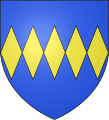

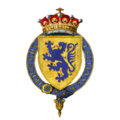


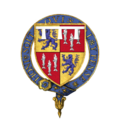





![Arms of Smithson of Stanwick, Yorkshire (ancient): Argent, a chevron engrailed sable between three oak leaves erect slipped vert[27]](http://upload.wikimedia.org/wikipedia/commons/thumb/6/67/SmithsonAncient.JPG/87px-SmithsonAncient.JPG)
![Augmented arms of Smithson Baronets of Stanwick to Sir Hugh Smithson, 1st Baronet by King Charles II of England for loyalty: Or, on a chief embattled azure three suns proper[28]](http://upload.wikimedia.org/wikipedia/commons/thumb/e/e6/SmithsonAugmentedArms.JPG/88px-SmithsonAugmentedArms.JPG)
![Monument of Sir Hugh Smithson, 1st Baronet (d.1670), St John the Baptist's Church, Stanwick, Yorks.[29]](http://upload.wikimedia.org/wikipedia/commons/thumb/b/b7/Smithson_tomb_chest%2C_St_John_the_Baptist_church%2C_Stanwick_-_geograph.org.uk_-_2018824.jpg/120px-Smithson_tomb_chest%2C_St_John_the_Baptist_church%2C_Stanwick_-_geograph.org.uk_-_2018824.jpg)



